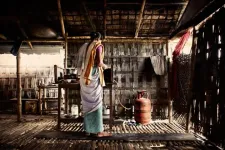(Press-News.org) Chestnut Hill, Mass. (6/29/2021) -- A new, first-of-its-kind study led by researchers from Boston College has found that personal networks in India could play an important role in advancing the adoption of a cleaner cooking fuel, in this case liquefied petroleum gas, according to a report published in the journal Environmental Research Letters.
"This is the first report in clean cooking research to show that just like with tobacco use, obesity, or physical activity -- where our networks play a role in shaping our behaviors and decisions -- we find that personal networks are also associated with what kinds of stoves rural poor use.," said study co-author and Boston College Assistant Professor of Social Work Praveen Kumar.
In rural India, particularly among those living in poverty, households rely widely on solid fuels such as firewood, charcoal, animal dung, and crop residue for household cooking. This use of traditional stoves has been linked to adverse health outcomes for household members and neighbors.
It has been estimated that household air pollution accounted for roughly 600,000 premature deaths in India in 2019, making it a leading cause of preventable deaths in the nation of 1.4 billion residents.
Government and non-governmental organizations have worked for decades to try to shift households to cleaner fuel sources, but slow progress has been attributed to economic, educational, and demographic barriers.
The researchers studied 198 respondents from roughly 30 villages in the southern Indian state of Andhra Pradesh. Respondents split evenly between those who adopted LPG and those who chose not to.
"We found that if there are a higher number of peers or friends who have cleaner cooking technology, that increases the likelihood of respondents to also have cleaner cooking technology," said Kumar, a scholar on energy access. "On the other hand if a respondent has a substantial number of friends with traditional cooking stoves, there is a higher likelihood that the respondent also has a traditional cooking stove."
In addition to Kumar, co-authors of the report include Boston College School of Social Work Dean Gautam Yadama, Liam McCafferty and Amar Dhand, of Harvard Medical School, Smitha Rao, of Ohio State University, Antonia Díaz-Valdés, of Universidad Mayor, Chile, and Rachel G Tabak and Ross C Brownson, of Washington University, St. Louis
"This study led by Kumar underscores the importance of behavioral and social drivers in the adoption and use of clean energy technologies, critical for improving health and environmental benefits for the poor," said Yadama, an authority on dissemination and implementation of clean energy systems to improve health and wellbeing of households in India.
The findings have implications for policy makers seeking ways to continue to convince poor households to shift to cleaner cooking fuels, said Kumar.
"The transition from traditional cooking to clean cooking is critically important -- not just in India. This is a global public health problem," said Kumar. "Governments have been working to support the transition, but more needs to be done. What we've found makes the argument that social policy around clean cooking needs to include personal network analysis and social network strategies. If personal networks are so important, there is a need to find residents who are influencers or opinion leaders and build targeted awareness campaigns involving them."
Kumar said the next steps in the research should explore the threshold of personal networks with cleaner stoves that could transition the households to cleaner cooking.
INFORMATION:
The tiny mouse embryo has a heart that beats. Its muscles, blood vessels, gut and nervous system are beginning to develop. But this embryo is unusual: It was made in a lab, out of mouse embryonic stem cells, and represents the most sophisticated in vitro (in a dish) model of a mammal ever so created.
This new model, developed at the University of Virginia School of Medicine by Christine and Bernard Thisse, is a major step forward in scientists' efforts to mimic the natural development of a mammal by using stem cells. Its existence is a wonder that will help scientists understand mammalian development, battle diseases, create new drugs and, eventually, grow tissues and organs for people in need of transplants.
"We found a way to instruct aggregates of stem cells to initiate ...
Immunologists at McMaster University have discovered a previously unknown mechanism which acts like a spider web, trapping and killing pathogens such as influenza or SARS-CoV-2, the virus responsible for COVID-19.
The researchers have found that neutrophils, the most abundant white blood cells in the human body, explode when they bind to such pathogens coated in antibodies and release DNA outside of the cell, creating a sticky tangle which acts as a trap.
The findings, published online in the Proceedings of the National Academy of Science, are significant because little is understood about how antibodies neutralize viruses in the respiratory tract.
The discovery has ...
One of the key mutations seen in the 'Alpha variant' of SARS-CoV-2 - the deletion of two amino acids, H69/V70 - enables the virus to overcome chinks in its armour as it evolves, say an international team of scientists.
SARS-CoV-2 is a coronavirus, so named because spike proteins on its surface give it the appearance of a crown ('corona'). The spike proteins bind to ACE2, a protein receptor found on the surface of cells in our body. Both the spike protein and ACE2 are then cleaved, allowing genetic material from the virus to enter the host cell. The virus manipulates the host cell's machinery to allow the virus to replicate and spread.
As SARS-CoV-2 ...
A conclusive narrative review has found physical punishment of children is not effective in preventing child behavior problems or promoting positive outcomes and instead predicts increases in behavior problems and other poor outcomes over time. The study by an international group of scientists including a researcher from The University of Texas at Austin was published today in The Lancet.
Caregivers in many parts of the world use physical punishment as a response to children's perceived misbehavior: 63% of children between the ages of 2 and 4 worldwide - approximately 250 million children - are regularly subjected ...
Phase 1/2 clinical trial of CoronaVac in 550 children and adolescents aged 3-17 years in China suggests two doses of the vaccine are safe and generate a strong antibody response.
First published data on safety and immune response generated by a COVID-19 vaccine in children as young as 3-years-old supports use of CoronaVac - which was recently approved for emergency use in China among children over 3-years-old - in further studies to inform immunisation strategies.
Two doses of CoronaVac are safe and provoke a strong antibody response among children and adolescents ...
In first-of-its kind research led by a University of Massachusetts Amherst psychotherapy researcher, mental health care patients matched with therapists who had a strong track record of treating the patients' primary concerns had better results than patients who were not so matched.
In addition, this "match effect" was even more beneficial and pronounced for patients with more severe problems and for those who identified as racial or ethnic minorities.
The findings are published in JAMA Psychiatry and the Journal of Consulting and Clinical Psychology.
"One of the things we've been learning in our field ...
PULLMAN, Wash. - A research team led by Washington State University has created a computer model to understand how plants store energy in the thylakoid membrane, a key structure to photosynthesis in plant leaves.
The team confirmed the accuracy of the mathematical model with lab experiments. Their work was recently published in the journal Nature Plants.
"We provided an important piece to the overall puzzle of plant metabolism," said Helmut Kirchhoff, a professor in WSU's Institute of Biological Chemistry and leader of the team who made this discovery. "If we integrate our model into the bigger picture, it may provide a good path for how to improve plants for ...
Two recent collaborative publications by CU Cancer Center members provide insights into how chronic inflammation can serve as a key factor in the development of leukemia and other blood cancers.
Eric Pietras, PhD, CU Cancer Center member and assistant professor in the CU School of Medicine Division of Hematology, and James DeGregori, PhD, deputy director of the CU Cancer Center and professor in the Department of Biochemistry and Molecular Genetics, were corresponding authors on both papers.
Both papers provide support for the theory of adaptive oncogenesis, which was developed by DeGregori. The theory stipulates that chronic inflammation (such ...
AMES, Iowa - During the course of a criminal investigation, it is common for investigators to interview individuals who are exhausted and have had little sleep. While unavoidable in some cases, a new Iowa State University study found sleep disruption or deprivation may limit the amount of information provided during an interview.
The study, published in the academic journal SLEEP, is one of the first to look at how sleep affects behavior during interrogations or interviews. Zlatan Krizan, an ISU professor of psychology, says while beliefs about the impact of sleep on interrogation subjects have existed for decades, he and co-authors, ISU professor Christian Meissner and graduate student Anthony Miller, found little direct scientific evidence related to its effectiveness. Krizan ...
A new national study finds that children in the United States with greater screen time usage at ages 9-10 are more likely to gain weight one year later.
The study, publishing in Pediatric Obesity on June 28, found that each additional hour spent on virtually all forms of screen time was associated with a higher body mass index (BMI) one year later. In particular, researchers found that each extra hour spent watching or streaming television, YouTube videos, video games, video chat, and texting led to a higher risk of weight gain one year later. At the start of the study, 33.7% of children were considered overweight ...




